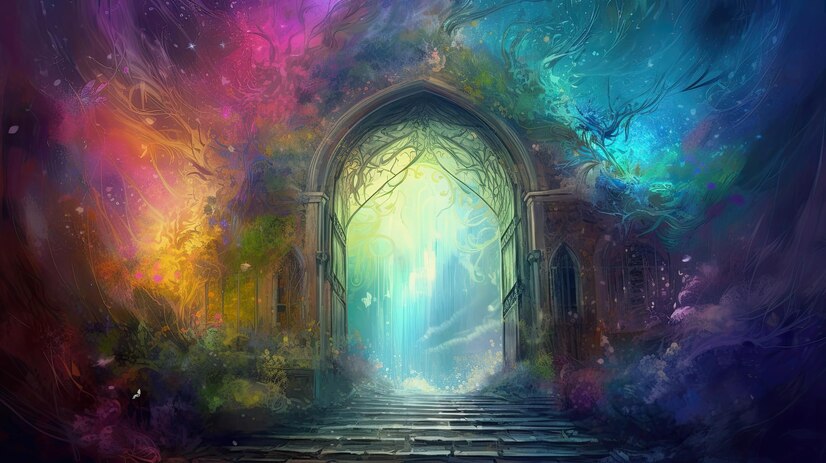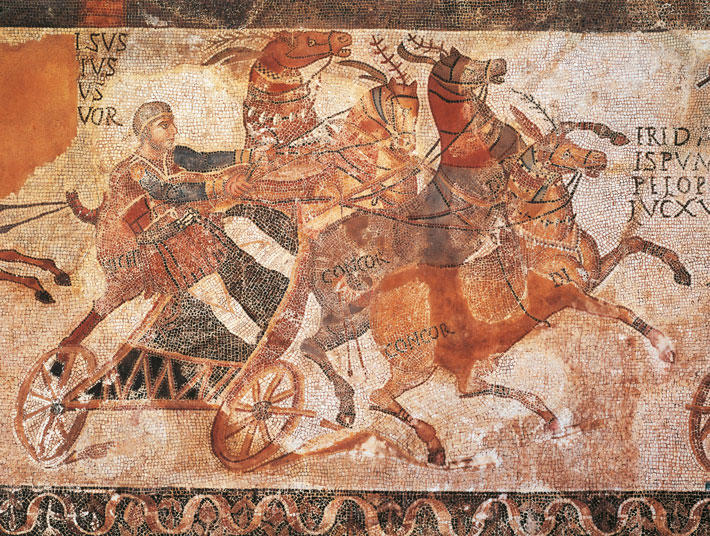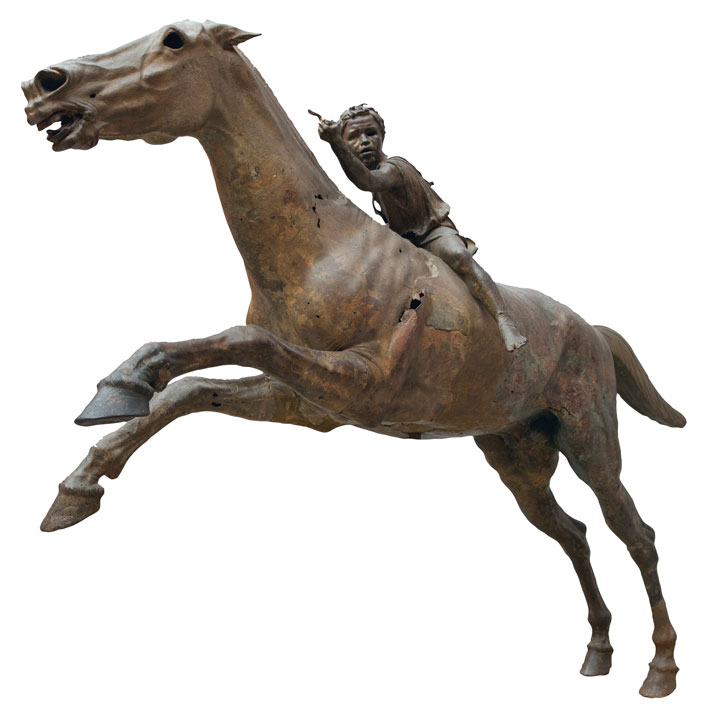It's NOT original, and therein lies our issue.
...................................................
The condition of a warlike culture may be diagnosed by the age of its gods -- and no, I don't mean familial succession or the literal number of years a religion has been practiced -- by "age of its gods" I mean the phase of development in which the god/goddess is depicted.
A side effect of the immaturity of the gods is the age, frequency, and fatality of coincident mortal heroes and the monsters/scenarios against which they struggle.
All too often in the Greek myths we have stories of an immature god/goddess spawning a young demi-god mortal hero/heroine,
who then grows up (if fortunate enough) to butt heads very painfully with the Idea of the Eternal.
...
I suppose my question would be, why such agony and birthing pain, and threat of death,
when the hero encounters the supernatural, in the ancient myths?
Why is the act of awakening into the role of hero so often fatal?
Why are so many heroic accounts Posthumous...?
...
Because of the Cults of Youth.
STOP FEEDING THE WAR GODS?
The role of the Greek goddess of Youth, Hebe:
(it will give you the Hebe jeebies lol)
https://en.wikipedia.org/wiki/Hebe_%28mythology%29
Hēbē (/ˈhiːbi/; Greek: Ἥβη)[1] in ancient Greek religion, is the goddess of youth[2] (Roman equivalent: Juventus).[3] She is the daughter of Zeus and Hera.[4] Hebe was the cupbearer for the gods and goddesses of Mount Olympus, serving their nectar and ambrosia, until she was married to Heracles (Roman equivalent: Hercules); her successor was Zeus' lover Ganymede. Another title of hers, for this reason, is Ganymeda. She also drew baths for Ares and helped Hera enter her chariot.[5]
A cup bearer is really just an idealized and glorified water bearer.
Traditionally, women often carried water to the laborers in the fields, and also to the warriors in the camps.
This evolved into the cup bearers of the royal courts and mead halls during times of relative peace and plenty.
The royalty and the privileged leaders liked to remind themselves of the resource of Youth,
upon which the kingdom could call in time of war.
As sci-fi writer Frank Herbert so aptly pointed out, the young males (and females!) are sent into combat by the core of non-breeding older males,
and this is mystified and legitimized through the "coming of age" rituals and the Cults of Youth.
And I'm not talking about any rock band or modern organization when I say CoY.
I'm talking about a human control mechanism that has been practiced for thousands of years...!
Baby Jesus Meek and Mild
It's ironic that in the Greek translations, and by default in the English, Christ's name has been changed from Yeshua (deliverer) to more closely resemble Zeus, who seems to be a crude permutation of the Mesopotamian Marduk, also a storm god (Zeus is known as "cloud gatherer").
https://en.wikipedia.org/wiki/Zeus
Zeus (English pronunciation: /ˈzjuːs/[3] ZEWS); Ancient Greek Ζεύς Zeús, pronounced [zdeǔ̯s] in Classical Attic; Modern Greek: Δίας Días pronounced [ˈði.as]) is the god of sky and thunder and the ruler of the Olympians of Mount Olympus. The name Zeus is cognate with the first element of Roman Jupiter, and Zeus and Jupiter became closely identified with each other.
Zeus is the child of Cronus and Rhea, and the youngest of his siblings. In most traditions he is married to Hera, although, at the oracle of Dodona, his consort is Dione: according to the Iliad, he is the father of Aphrodite by Dione.[4] He is known for his erotic escapades. These resulted in many godly and heroic offspring, including Athena, Apollo, Artemis, Hermes, Persephone (by Demeter), Dionysus, Perseus, Heracles, Helen of Troy, Minos, and the Muses (by Mnemosyne); by Hera, he is usually said to have fathered Ares, Hebe and Hephaestus.[5]
Where Zeus differs strongly from Marduk, who is more of an essential warrior,
is in Zeus being the youngest of many children. I did say this thread wasn't about familial succession, but this detail can't be ignored when we are dealing with Zeus, since Hebe performs the role of Goddess of Youth in his stead.
It could be said that Zeus is portrayed as being very immature if not young.
It would have been earlier, around the time of Egypt's dominion if not sooner,
that the Chariot became iconic in the world's religions, as possession of chariots in general provided Mid East kingdoms with tactical superiority.
We have here the combination of two symbols, one very old and the other very young, relatively:

Zeus on his chariot --
He might not be THE sun god, but the symbolism of the chariot wheels mirroring the sun following the cloud gatherer is also undeniable.
Apollo wasn't directly linked with the sun either, although similarly to Zeus he is seen drawing the Solar Chariot as well,
which according to the poets was the job of Helios:
Strangely enough, Chariots play a central role also in certain forms of Jewish mysticism:https://en.wikipedia.org/wiki/Helios
Despite these identifications, Apollo was never actually described by the Greek poets driving the chariot of the sun, although it was common practice among Latin poets. Therefore, Helios is still known as the 'sun god' – the one who drives the sun chariot across the sky each day.
Helios - Wikipedia, the free encyclopedia
https://en.wikipedia.org/wiki/Merkabah_mysticism
The angel who visited the well known mystic Edgar Cayce took the form of a charioteer who carried no weapon.Merkabah/Merkavah mysticism (or Chariot mysticism) is a school of early Jewish mysticism, c. 100 BCE – 1000 CE, centered on visions such as those found in the Book of Ezekiel chapter 1, or in the hekhalot ("palaces") literature, concerning stories of ascents to the heavenly palaces and the Throne of God. The main corpus of the Merkabah literature was composed in Israel in the period 200–700 CE, although later references to the Chariot tradition can also be found in the literature of the Chassidei Ashkenaz in the Middle Ages.[1] A major text in this tradition is the Maaseh Merkabah (Works of the Chariot).[2]
Unfortunately for modern mystics, there are plenty of shills who latched on to the appeal of Chariot Mysticism,
and finding a real teacher might not be so easy, hah.
The thing that's interesting about Cayce's experience, though, was that he witnessed the vision as an old man, if I am not mistaken.
The figures in his visions were not necessarily youthful; rather, they were ageless.
That the angel used the chariot as a symbol of spiritual conveyance doesn't necessarily mean it was a warlike countenance.
In fact the chariot was accompanied by the sound of swarming bees.
(If I am not mistaken, a swarm of 15,000 bees had to be removed from the doorway of the US Senate building this week).
So, we go back to Hebe. Although not necessarily associated with the honeybee, in spite of the similarly sounding name, being the cup bearer of the gods' Ambrosia does in fact link her to the practice of brewing and serving beverages made from honey, which is a practice of the nomadic peoples who predated the known civilizations.
Therefore we have ancient symbols residing in what modern people take to be symbols of youth.
Although Hebe is the goddess of youth, she carries the vessel containing the distilled water and honey-vitalized, lavender-flavored, beverage of the ancients.
Honey is thought to have been the one substance that leveraged ancient Mankind out of the hunter-gatherer mode and into civilized living, at least part of the time. Human use of honey is coincident with the advent of singing and recorded language.
Many cultures who wrote on tablets also used the honeybee as a central icon in their societies.
The bee is actually a messenger of the Underworld, or the spirit world, in some belief sets.
It appears in the story of Samson, in the Bible, as well; in the passage where Samson kills a young lion, then returns to view the corpse,
he is witness to a swarm of bees who have taken up residence in the body of the lion, and have stockpiled their honey inside the ribcage.
Although most people would be deterred by the rancid corpse, Samson being a thrill seeker wanted to experience the cheap & free energy of eating the tainted honey.
Because he was chastised, if not punished at that time, Samson stands alone from Hebe and Zeus for eating honey;
he is cursed for taking the shortcut to power and pleasure rather than waiting on God.
The theme of honey being advantageous to tired people appears again in the Bible, where Saul's son Jonathan eats honey,
not realizing that his father forbade the army from eating that day.
I think the story of Jonathan and the honey is almost as fascinating as the story of the prophets being fed by ravens.
In each case, people are saved by miraculous means. Jonathan is a youthful character, however, and the prophets were generally older when they spent time fleeing from kings living in caves. And bread by ravens is symbolic also of the death of the body, which the prophets anticipate by disobeying the king.
It is no accident that the god of bad tidings in Norse tradition is attended by ravens. (Odin).
the fact that humans tend to consider news of death "Bad tidings" is further evidence of our obsession with eternal youth.
The writer Neil Gaiman, although not very original himself, deals with the idea of youth cults getting old,
in his cooperation with Mike Carrey in the storyline "The Wolf Beneath the Tree" -- a passage of this story features the Norse god of youth Idun,
who tires of modern life and the way that children have always been sent away to war. Idun comments before perishing in the story that it's been this way as long as he can remember, and the knowledge of it (the loss of innocence) has begun to wear him down.
I think it's very interesting that the Senate got mobbed by bees.
Some would say that it's a bad omen, that there is rot in the place,
also that the ancient gods are angry about the misuse of the youth of the land.
I will write more on this as able but alas, unlike Idun I am not longer that young, lol.
Christ has only 1 physical year on me --
and I don't want to offend Christians here,
but Christ is next on the examination table,
because we're gonna talk about the Fisher King, the sacrificed king, the king of the forest,
and of course Christ and Mithraism.
Because there's got to be a connection between the whole Madonna and Child motif,
and the being immortalized by dying early and being mourned, along with the idea of resurrection.
p.s. examples of modern American kids being taught to fall in love with early death:
Twilight, TrueBlood




